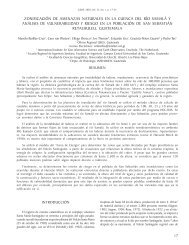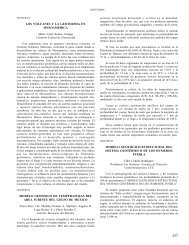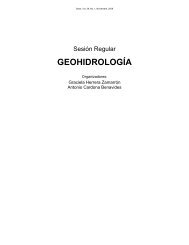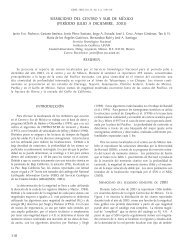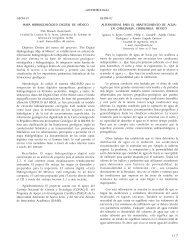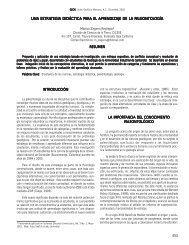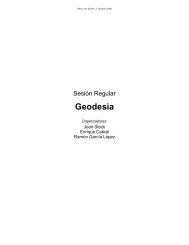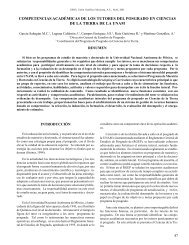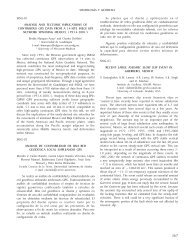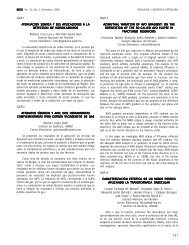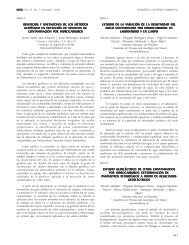Libro de Resúmenes - Unión Geofisica Mexicana AC
Libro de Resúmenes - Unión Geofisica Mexicana AC
Libro de Resúmenes - Unión Geofisica Mexicana AC
You also want an ePaper? Increase the reach of your titles
YUMPU automatically turns print PDFs into web optimized ePapers that Google loves.
VULCANOLOGÍA Geos, Vol. 30, No. 1, Noviembre, 2010<br />
izquierda). Para obtener esto se utiliza una distribución lognormal generalizada<br />
<strong>de</strong> cuatro parámetros. El motor interno <strong>de</strong> optimización <strong>de</strong> DECOLOG ha sido<br />
fuertemente mejorado utilizando los algoritmos <strong>de</strong> optimización multiobjetivos,<br />
“Differential evolution” (DE) y “Trigonometric differential evolution (TDE),<br />
los cuales incrementan notablemente la velocidad <strong>de</strong> convergencia <strong>de</strong> las<br />
funciones, la significatividad y reproducibilidad <strong>de</strong> los resultados finales.<br />
DECOLOG 3.0 se distribuye gratuitamente (www.<strong>de</strong>colog.org) por la comunidad<br />
científica y ha encontrado aplicaciones en diferentes disciplinas.<br />
instrumentar volcanes con sensores <strong>de</strong> banda ancha para un mejor análisis y<br />
monitoreo <strong>de</strong> la actividad.<br />
VUL-32 CARTEL<br />
THE RECENT <strong>AC</strong>TIVITY PHASE (1998-2010) AT VOLCAN<br />
DE COLIMA, MEXICO BY THE MONITORING OF<br />
DEFORMATION PARAMETER USING THE TILT METER NET<br />
Ramírez Ruíz Juan José, Alatorre Chávez Eliseo,<br />
Santiago Jiménez Hydyn y Campos G. Arnoldo<br />
Universidad <strong>de</strong> Colima<br />
ramirez@ucol.mx<br />
The recent unrest at an<strong>de</strong>sitic Volcán <strong>de</strong> Colima, México began on November<br />
1997 with a sharp increase in seismic activity and a significant shortening of<br />
geo<strong>de</strong>tic lines around the volcano edifice. During this period of activity 5 lava<br />
extrusions are occured: November 1998, May 2001, September 2004, February<br />
2007 and 2009. The tilt meter <strong>de</strong>formation net is composed of 5 plate sensors<br />
of Applied Mechanics (Series 702 x). The sensors register analogic signals that<br />
correspond to Radial and Tangential components and the temperature of the<br />
site. The signals are digitized and transmitted by telemetry systems to the Colima<br />
Volcano Observatory. During this stage of activity we observed the behaviour<br />
of the <strong>de</strong>formation parameter in relation to the different activities stages of the<br />
Volcan <strong>de</strong> Colima. Here we can i<strong>de</strong>ntify the 2001-2002 and 2004-2005 and<br />
2008-2010 lava extrusions, and 1999, 2005 explosively phases and the calm<br />
phases of 2006 and 2007. The actual lava dome extrusion of 2010 shows a very<br />
slow growht in comparision to the 1998 and 2004. For the analysis of <strong>de</strong>formation<br />
parameter we consi<strong>de</strong>r climatic factors that influence the sensores. Here will be<br />
presented the interpretation of the tilt meter surveys during the recent unrest<br />
phase and its correlation with the risk poupulation assented around the volcano<br />
edifice.<br />
VUL-33 CARTEL<br />
LOCALIZ<strong>AC</strong>IÓN DE SISMOS VOLCÁNICOS<br />
UTILIZANDO SUS AMPLITUDES, CON SENSORES<br />
DE BANDA ANCHA EN EL VOLCÁN DE COLIMA<br />
Arámbula Mendoza Raúl 1 , Valdés González Carlos 2 ,<br />
Lesage Phillipe 3 , Legrand Denis 4 y Reyes Dávila Gabriel 5<br />
1 Posgrado en Ciencias <strong>de</strong> la Tierra, Instituto <strong>de</strong> Geofísica, UNAM<br />
2 Departamento <strong>de</strong> Sismología, Instituto <strong>de</strong> Geofísica, UNAM<br />
3 Laboratoire <strong>de</strong> Géophysique Interne et<br />
Tectonophysique, CNRS, Université <strong>de</strong> Savoie, France<br />
4 Departamento <strong>de</strong> Vulcanología, Instituto <strong>de</strong> Geofísica, UNAM<br />
5 Centro Universitario <strong>de</strong> Estudios e Investigaciones<br />
en Vulcanología, Universidad <strong>de</strong> Colima<br />
rul_arambula@hotmail.com<br />
Eventos sísmicos volcánicos como los LP’s, explosiones, tremores, <strong>de</strong>rrumbes<br />
y lahares son difíciles <strong>de</strong> localizar con métodos tradicionales, <strong>de</strong>bido a la falta <strong>de</strong><br />
fases bien <strong>de</strong>finidas <strong>de</strong> ondas P y S. Por lo que, nuevas técnicas han permitido<br />
en los últimos años inferir la posible ubicación <strong>de</strong> este tipo <strong>de</strong> eventos. Una <strong>de</strong><br />
ellas, está basada en el <strong>de</strong>caimiento <strong>de</strong> la amplitud con la distancia. Para ello, se<br />
<strong>de</strong>be <strong>de</strong> suponer una ley <strong>de</strong> atenuación <strong>de</strong> ondas <strong>de</strong> cuerpo para explosiones,<br />
tremores y LP’s y otra para eventos superficiales como <strong>de</strong>rrumbes o lahares.<br />
De igual forma, es necesario generar una malla en don<strong>de</strong> se presupone la<br />
existencia <strong>de</strong> dichas fuentes, tanto para los eventos internos, como para los<br />
sismos <strong>de</strong> origen superficial. En dicho análisis se consi<strong>de</strong>ra que la fuente es<br />
isotrópica y el medio es homogéneo. Este estudio ha sido hecho durante el<br />
reciente periodo <strong>de</strong> actividad <strong>de</strong>l Volcán <strong>de</strong> Colima. Actualmente la red <strong>de</strong><br />
monitoreo cuenta con 5 estaciones <strong>de</strong> banda ancha, pertenecientes a la RESCO<br />
(Red Sísmológica Telemétrica <strong>de</strong>l Estado <strong>de</strong> Colima). La red no sufre saturación<br />
en explosiones o LP’s gran<strong>de</strong>s, como ocurre con los sensores <strong>de</strong> periodo corto.<br />
Inicialmente se ha calculado el efecto <strong>de</strong> sitio <strong>de</strong> cada estación con ayuda<br />
<strong>de</strong> sismos regionales. De igual forma, se han utilizado diferentes ventanas <strong>de</strong><br />
análisis, filtros, factores <strong>de</strong> calidad ‘Q’, velocidad <strong>de</strong> las ondas, para finalmente<br />
quedarnos con los mejores parámetros, que minimizan el residual entre las<br />
curvas teóricas y los valores observados (amplitu<strong>de</strong>s calculadas con RMS’s).<br />
Los resultados han <strong>de</strong>mostrado coherencia con la actividad actual, por ejemplo,<br />
<strong>de</strong>rrumbes localizados hacia el oeste <strong>de</strong>l volcán, que es por don<strong>de</strong> actualmente<br />
está bajando material juvenil, como consecuencia <strong>de</strong>l <strong>de</strong>sbordamiento <strong>de</strong>l<br />
domo <strong>de</strong> lava. Para los LP’s, explosiones y tremores, estos se presentan en<br />
profundida<strong>de</strong>s someras, menores a 3 km por <strong>de</strong>bajo <strong>de</strong>l cráter, muy similares<br />
a las observadas en otros volcanes. Con esto se <strong>de</strong>muestra la importancia <strong>de</strong><br />
110



![Libro de resúmenes [revisión final, 172 páginas] - UGM](https://img.yumpu.com/51565067/1/190x245/libro-de-resamenes-revisian-final-172-paginas-ugm.jpg?quality=85)
